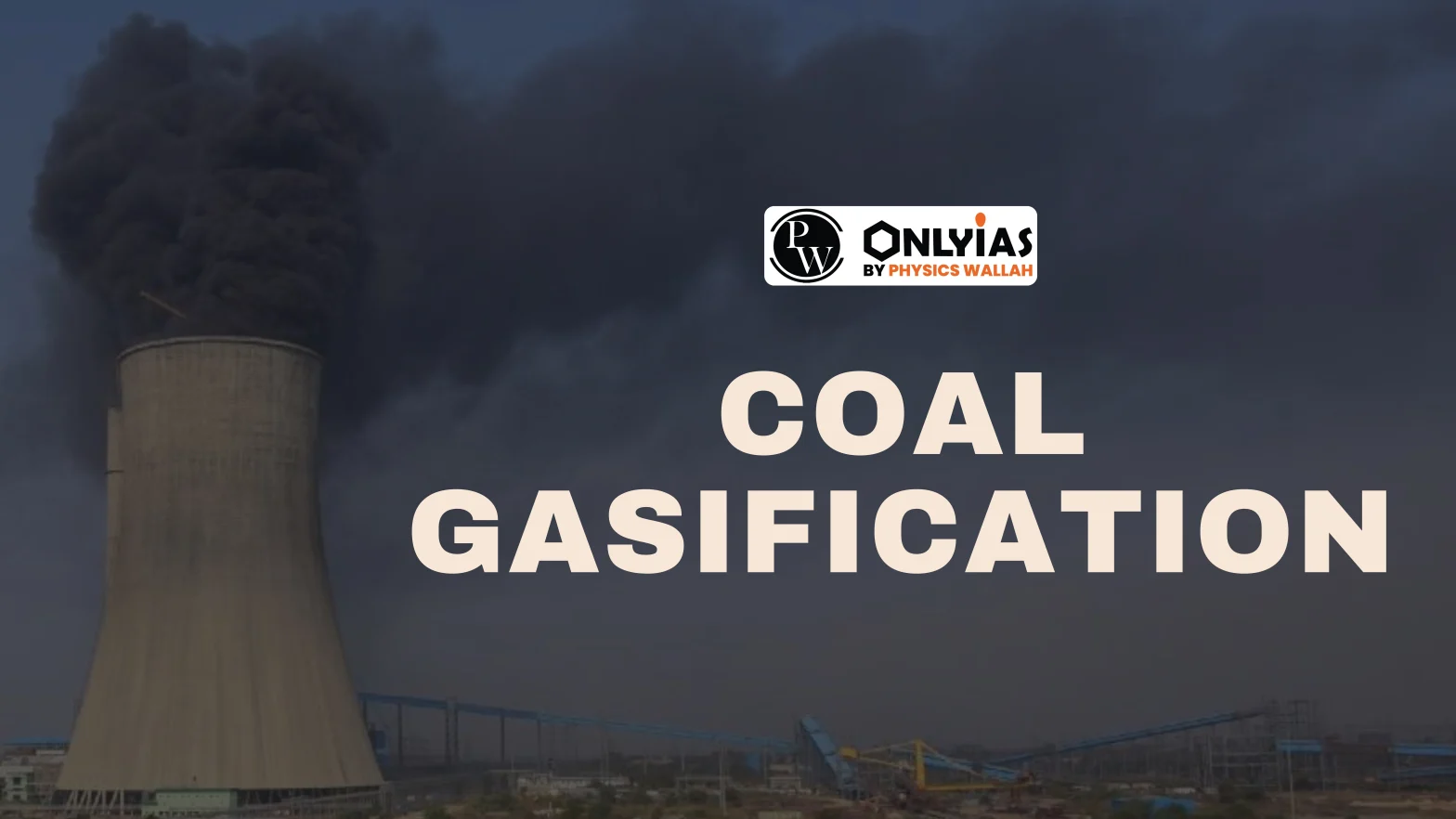About the Coal Gasification Scheme
- Third Category: Under this, Rs 600 crore has been provisioned for demonstration projects (indigenous technology) or small-scale product-based gasification plants.
- A lump-sum grant of Rs 100 crore or 15 per cent of capex, whichever is lower, will be given to the selected entity.
- Selection of Entities: The selection of entities under categories II and III through a competitive and transparent bidding process.
What is Coal Gasification?
Coal Gasification is a thermo-chemical process that converts coal into simple molecules, primarily carbon monoxide and hydrogen, called synthesis gas or syngas.
- Mechanism: In the gasification process, coal is partially oxidised by air, oxygen, steam, or carbon dioxide under controlled conditions to produce a liquid fuel known as syngas.
- Significance: The combustion of this gas is cleaner and more efficient than coal combustion since emissions are trapped at the gasification stage.
- Methods of Coal Gasification:
- In-situ method: In this, oxygen is infused into the seam together with water and ignited at high temperatures, causing coal to partly oxidize int hydrogen, CO, carbon dioxide (CO2), methane (CH4), and hydrogen sulfide (H2S).
- Ex-situ reactors: They are designed to simulate the gasification process above the ground’s surface.
- Sulphur in coal is transformed to H2S and trace volumes of carbonyl sulphide (COS) during the gasification process.
Enroll now for UPSC Online Course
Need for Coal Gasification
- A Proven Reserve of Thermal Coal: A country’s total estimated coal reserve (resource) per the Coal Inventory published by GSI, as of 01.04.2022 is 361411.46 million tonnes.
- Global Standing: Second largest in the world after China.
- Production Surge: 14.8% rise in production reaching 893 MT in the 2022-2023 financial year.
- Contribution: India contributes more than 10% of the global coal production.
- Coal Gasification Target: The government has launched the National Coal Gasification Mission to achieve coal gasification and liquefaction of 100 MT of coal by 2030.
- Government Production Target:
- The Government aims for self-reliance by boosting domestic production.
- Targeting over 1 billion tonnes in 2023-2024 and further increase it to 1.5 billion tonnes by 2029-2030.
- Reducing Import Dependency: India has a huge dependency on imports of crude and natural gas-based products mainly methanol, ammonia, ammonium nitrate, and olefins, which can be easily substituted by by-products derived from syngas.
- Transition to Sustainable Energy: India has huge reserves of coal, it would benefit India if it finds a sustainable way of using these reserves as the world including India is gradually transitioning away from coal toward cleaner fuels in the wake of climate change.
- Sustainable Usage of Coal: Given India’s growth potential and rising demand for power, the demand for coal is projected to rise from the current requirement of nearly one billion tonnes to 1.5 billion tonnes by 2029-30.
- Pharmaceutical Industry: India plans to produce active pharmaceutical ingredients (API) domestically rather than importing them from China.
- There is a high potential for Syngas to make APIs and methanol as a solvent.
- Cleaner and environmentally Friendly: Coal gasification plants produce no scrubber sludge.
- The majority of the wash water is reprocessed, and residual wastewater from gasification plants can be treated effectively.
- As a result, coal gasification is considered a cleaner coal technology than coal combustion.
Challenges with Coal Gasification in India
- Inferior Quality of Coals: The high ash content in Indian coal is a technical barrier to a larger adoption of coal gasification.
- The ash percentage of indigenously available coal ranges between 30-35 per cent even after washing, which is quite high.
- Induced Subsidence of Surrounding Rocks: The space created by deep mining during the coal gasification may cause significant deformation in the remaining coal and surrounding rocks.
- Occupational Hazard: The coal Gasification process cannot be controlled to the same extent as surface gasifiers, which poses the risk of high temperature and pressure in the cavity, furthering the workers’ risk.
- Environmental Factors: According to some studies, coal gasification generates more CO2 than a conventional coal power station.
- Groundwater Contamination: While the nation already faces water scarcity, coal gasification is a more water-intensive energy generation method.
- Economy of Projects: It is an inherently ‘unsteady’ state process; the flow rate and the heating value of the product gas will vary over time.
- Changes in the quantity and quality of gas produced will significantly impact the project’s economics.
- Technological Concern: Lack of availability of proven gasification technology suitable for poor poor-quality Coal.
Way Forward
- Regulation on Ash Content: The ash content of coal supplies needs to be enforced. Present regulations limiting ash content to 34% are not being enforced.
- Coal washeries pose challenges regarding investment, water usage and water disposal.
- Coal blending is the path forward, as waste streams from the gasification process are easier to handle and can be value-adding in themselves (e.g. sulphur, slag).
- Level Playing Field: Exemption from currently applicable Cess / Duties on Coal Feedstock prices should be provided for environment- friendly Coal Gasification Projects due to its Clean Technology adaptation.
- National Policy on Coal Gasification & Liquefaction: This should be urgently formulated and promulgated for faster and smoother implementation of Coal Gasification Projects.
- Dedicated Closed Coal Mines for Coal Gasification: Coal Mines should be earmarked for Coal Gasification Projects (to be awarded through Auction Linkage) for better Coal Quality consistency, sustained Supply & closer Mining & Transportation Cost control.
- Viability Gap Funding: Financial incentives from the government to support very high CAP of gasification projects needed to improve the viability of ‘Energy Security’ (Clean) projects.
Check Out UPSC Modules From PW Store
Conclusion
Coal gasification offers a cleaner energy alternative, but overcoming technical and environmental challenges requires robust regulations, financial incentives, and sustainable practices to ensure successful implementation.
![]() 4 Jul 2024
4 Jul 2024

